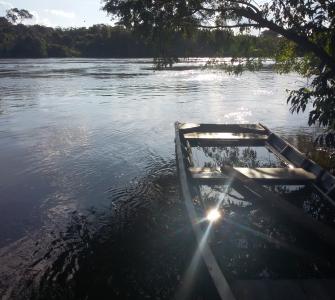Conservação Estratégica (CSF-Brazil), in partnership with Instituto Centro de Vida (ICV, Institute of Life Center), International Rivers and Operação Amazônia Nativa (OPAN, Native Amazon Operation), carried out a detailed study on the construction of the proposed Castanheira hydropower plant on the Arinos river, in the state of Mato Grosso, Brazil. This study had three goals: (1) evaluate the financial feasibility of the project; (2) contribute to the analysis of socio-environmental impacts associated with the construction of hydroelectric dams in the Amazon region; and (3) provide information to decision makers about this type of infrastructure through a cost-benefit analysis of the dam.
The Arinos River, located in the Upper Tapajós River Basin in the municipality of Juara, is known for its richness and fish biodiversity, and is an important source of income and leisure for the local community. According to the Ten-Year Energy Plan 2026, developed by the Brazilian Federal Energy Planning Company, the construction of the Castanheira hydroelectric dam in this region is necessary to meet the future demand for electricity in Brazil. However, given the likely negative socio-environmental impacts and the high initial cost relative to the quantity of electricity produced, civil society organizations are questioning whether it’s worth constructing the Castanheira dam at all.
Within this context, CSF-Brazil conducted a study with its partners on the construction of the proposed Castanheira Dam. This study was divided into three stages: first, we evaluated the financial feasibility of the hydropower plant and its contribution to the Brazilian energy matrix. We did not include the socio-environmental impacts associated with the construction of the hydroelectric plant in this stage. In the second stage, we evaluated the economic impacts, considering some of the socio-environmental impacts resulting from the construction of the dam. Out of all the potential impacts, we analysed: (i) greenhouse gas emissions; (ii) the opportunity cost of the flooded area; and (iii) the potential impact on fishing activities. Although we did not quantify, we discussed the potential impacts of the construction of this hydropower plant on the indigenous population and on the development of the host cities (Juara and Novo Horizonte do Norte). The results were combined and, in the third stage, we conducted a cost-benefit analysis of the construction of the proposed Castanheira dam.
Using traditional financial indicators, our best estimates are that the Castanheira Dam would generate a loss to the operator of approximately US$ 81 million. If we include the costs of net greenhouse gas emissions, economic losses from flooded productive areas and diminished fish stocks downstream, the potential loss generated by this project could increase to US$ 142 million. Thus, our results show that, if built and operating according to parameters given in official documents, the dam will not be financially feasible.
We recommend that the government of Brazil should review the financial assumptions in the official documents, as well as the monetary quantification of the impacts associated with the proposed Castanheira Dam project. More broadly, the analysis carried out reinforces the need to quantify all potential impacts in addition to calculating financial feasibility. Most important, however, is the existence of an open and transparent discussion among different sectors of the economy, including policymakers and civil society organizations, on the potential benefits and adverse effects caused by dams. Such discussion should also consider the costs and benefits of alternative sources of energy so trade-offs can be accurately compared.
The results of the study were presented to the local community and federal institutions such as the Energy Research Company, and the Ministry of Mines and Energy. These results will also be presented in public hearings in the coming months, with the goal of influencing decision making towards more efficient and sustainable energy alternatives. Through a technical and transparent study, we hope to contribute to the local and national debate on the construction of hydroelectric plants in the Brazilian Amazon region.
Currently, the Castanheira dam is in the process to obtain its Preliminary Permit (click here for more information).
Please, click here to download our full study (in Portuguese); here for our Policy Brief (in English); and here for more information on our results and our workshop for results presentation.
To read the article (in Portuguese) written by Andreia Fanzere from OPAN, in which our results are mentioned, please click here.
Photo credit: Michel de Andrade.
Photo description: The picture above is of the region of the Upper Tapajós River Basin, in the Sub-basin of the Juruena River, in Mato Grosso which is a place of great beauty.

